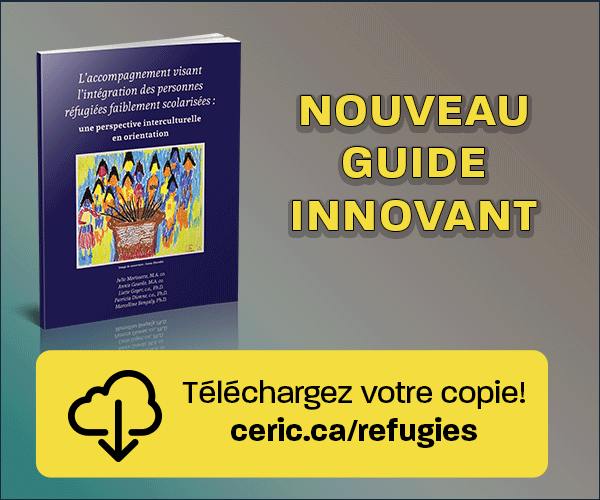Difficultés de prise de décision de carrière des étudiants de première année
Mots-clés :
décision de carrière, étudiant de première année, université, canadien, étudiantRésumé
First-year university students often experience career indecision and related career decision-making difficulties. Gati, Krausz, and Osipow (1996) developed a taxonomy for understanding the various difficulties contributing to career indecision. The focus of the current study was to examine their taxonomy with a Canadian sample of university students in relation to career decision-making self-efficacy, sex-role identification, and stage of identity development. Our results indicated a significant negative correlation between career decision-making difficulties and self-efficacy, which discriminated among degree of career indecision and whether or not students had changed their career plans since attending university. Also, there were some significant sex-role orientation and stage of identity differences for some of these variables. Implications for career counsellors are discussed.
Références
Bandura, A. (1986). Social foundations of thought and action. New Jersey: Prentice-Hall.
Belenky, M. F., Clinchy, B. M., Goldberger, N. R., & Tarule, J. M. (1997). Women’s ways of knowing: The development of self, voice, and mind. New York: Basic Books, Inc.
Bem, S. L. (1981). Bem sex-role inventory. Redwood City, CA: Consulting Psychologists Press.
Bennion, L. D. & Adams, G. R. (1986). A revision of the Extended Version of the Objective Measure of Ego Identity Status: An identity instrument for use with late adolescents Journal of Adolescent Research, 1, 183-198.
Betz, N. E., Klein, K. L., & Taylor, K. M. (1996). Evaluation of a short form of the Career Decision Making Self-Efficacy Scale. Journal of Career Assessment, 4, 47-57.
Betz, N. & Voyten, K. (1997). Efficacy and outcome expectations influence career exploration and decidedness. The Career Development Quarterly, 46, 179-189.
Blustein, K. L. (1989). The role of goal instability and career self-efficacy in the career exploration process. Journal of Vocational Behavior, 35, 194-203.
Chickering, A. W., & Reisser, L. (1993). Education and identity (2nd ed.). San Francisco: Jossey-Bass.
Dawson-Threat, J., & Huba, M. E. (1996). Choice of major and clarity of purpose among college seniors as a function of gender, type of major, and sex-role
identification. Journal of College Student Development, 37, 297-308.
Degen, G. & Ness, D. V. (2001). The relationship between university students’ career exploration behaviour and their career decision-making self-efficacy. Manuscript in preparation.
Erikson, E. H. (1968). Identity: Youth and crisis. New York: Norton.
Gati, I., Krausz, M., & Osipow, S. H. (1996). A taxonomy of difficulties in career decision- making. Journal of Counseling Psychology, 43, 510- 526.
Hackett, G. (1995). Self-efficacy in career choice and development. In A. Bandura (Ed.), Self-efficacy in changing societies (pp. 232-258). New York: Cambridge University Press.
Hackett, G., & Betz, N.E. (1992). Self efficacy perceptions and the career related choices of college students. In D. H. Schunk, & J. L. Meece (Eds.), Student perceptions in the classroom (pp. 229-246). Hillsdale, NJ: Lawrence Erlbaum Associates, Inc.
Hackett, G., & Betz, N. E. (1995). Self efficacy and career choice and development. In. J. E. Maddux (Ed.), Self-efficacy, adaptation, and adjustment: Theory, research, and application (pp. 249-280). New York: Plenum Press.
Jome, L. M., & Tokar, D. M. (1998). Dimensions of masculinity and major choice traditionality. Journal of Vocational Behavior, 52, 120- 134.
Knefelkamp, L. L. & Slepitza, R. (1976). A cognitive-developmental model of career development: An adaptation of the Perry scheme. The Counseling Psychologist, 6,
-58.
Lancaster, B. P., Rudolph, C. E., Perkins, T. S., & Patten, T. G. (1999). The reliability and validity of the Career Decision Difficulties Questionnaire. Journal of Career Assessment, 7, 393-413.
Marcia, J. E. (1966). Development and validation of ego identity status. Journal of Personality and Social Psychology, 3, 551-558.
Marcia, J. E. (1980). Identity in adolescence. In J. Adelson (Ed.), Handbook of adolescent psychology, (pp. 159-187). New York: Wiley.
Marsh, H. W., & Myers, M. (1986). Masculinity, femininity, and androgyny: A methodological and theoretical critique. Sex Roles, 14, 397-430.
Mazen, A. M., & Lemkau, J. P. (1990). Personality profiles of women in traditional and non-traditional occupations. Journal of Vocational Behavior, 37, 46-59.
Osipow, S. H. (1999). Assessing career indecision. Journal of Vocational Behavior, 55, 147-154.
Ricciardelli, L. A., & Williams, R. J. (1995). Desirable and undesirable gender traits in three behavioural domains. Sex Roles, 33, 637-655.
Spence, J. T. (1993). Gender-related traits and gender ideology: Evidence for a multifactorial theory. Journal of Personality and Social Psychology, 64, 624-635
Super, D. E. (1990). A life-span, lifespace approach to career development. In D. Brown & L. Brooks (Eds.), Career choice and development: Applying contemporary theories to practice (pp. 197-261). San Francisco: Jossey-Bass/Pfeiffer.
Tokar, D. M., & Jome, L. M. (1998). Masculinity, vocational interests, and career choice traditionality: Evidence for a fully mediated model. Journal of Counseling Psychology, 45, 424-435.
Vondracek, F. W., Schulenberg, J., Skorikov, V., Gillespie, L. K., & Wahlheim, C. (1995). The relationship of identity status to career indecision during adolescence. Journal of Adolescence, 18, 17-29

Téléchargements
Publié-e
Comment citer
Numéro
Rubrique
Licence

Cette œuvre est sous licence Creative Commons Attribution - Pas d'Utilisation Commerciale - Pas de Modification 4.0 International.











